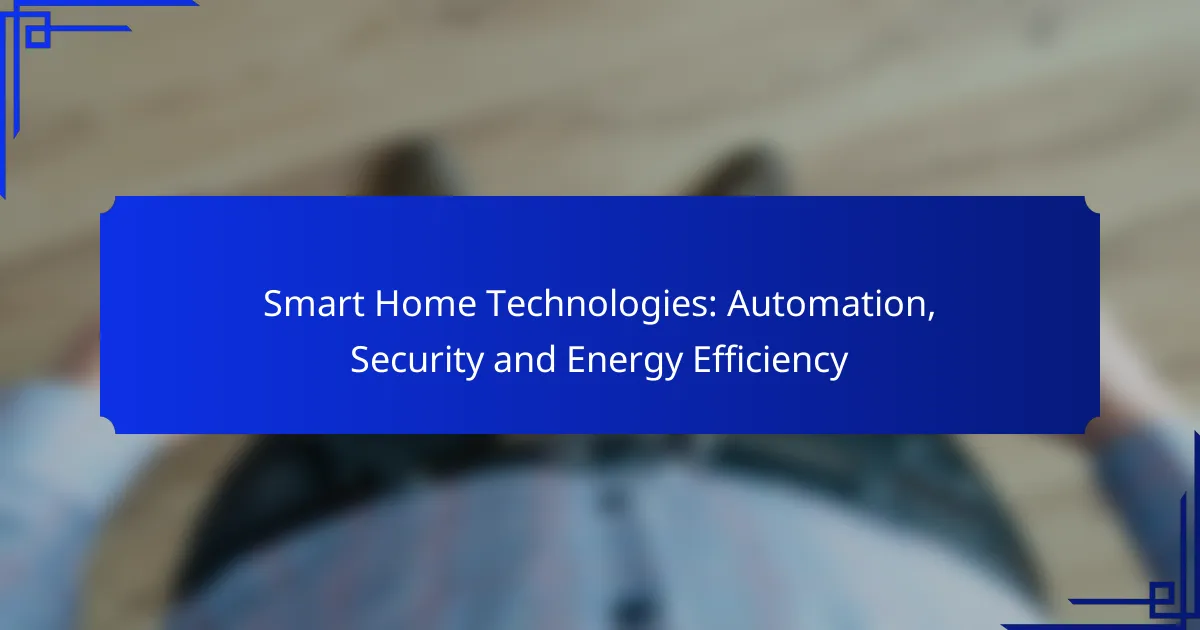Smart home technologies are revolutionizing the way we live by integrating automation, security, and energy efficiency into our daily routines. With devices like Amazon Alexa and Google Nest Hub, homeowners can enjoy enhanced convenience while ensuring their homes are secure and energy-efficient. These interconnected systems provide real-time monitoring and control, making it easier to manage everything from security alerts to energy consumption.
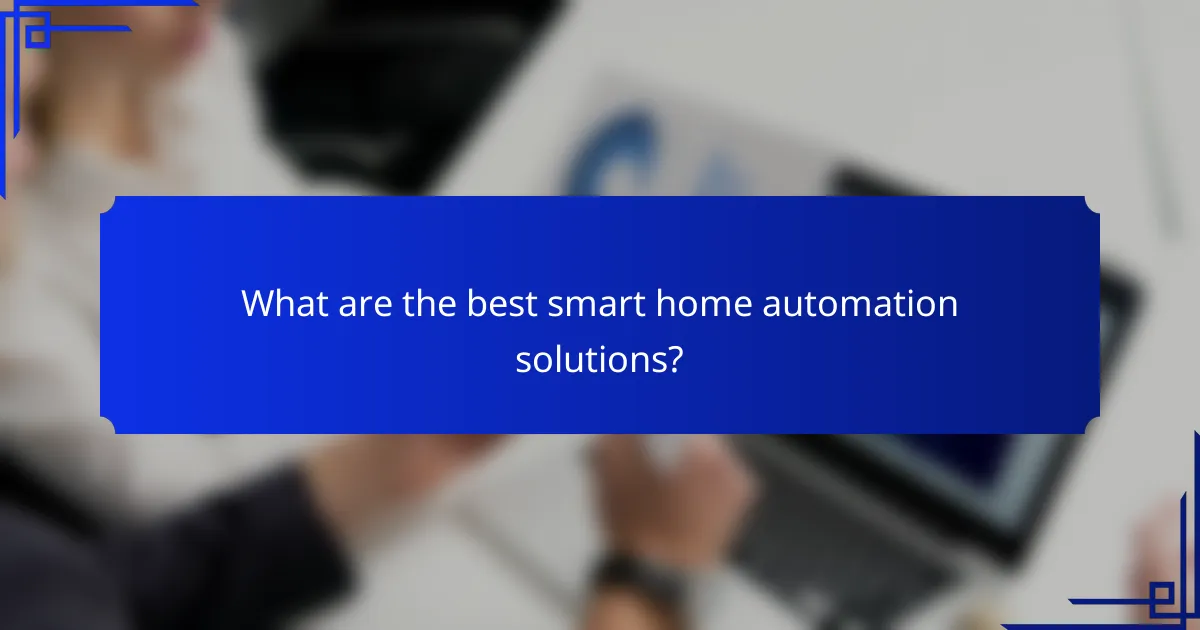
What are the best smart home automation solutions?
The best smart home automation solutions enhance convenience, security, and energy efficiency through interconnected devices. Popular options include Amazon Alexa, Google Nest Hub, Apple HomeKit, and Samsung SmartThings, each offering unique features and integrations.
Amazon Alexa
Amazon Alexa is a voice-activated assistant that controls smart home devices through simple voice commands. It supports a wide range of compatible devices, allowing users to manage lighting, thermostats, and security systems effortlessly.
To get started, set up an Echo device and connect it to your Wi-Fi network. Then, use the Alexa app to add compatible devices. Be mindful of device compatibility and ensure your smart products are Alexa-enabled for seamless integration.
Google Nest Hub
The Google Nest Hub serves as a central control panel for your smart home, featuring a touchscreen interface for easy navigation. It integrates with Google Assistant, enabling voice commands and visual control of connected devices.
To utilize the Nest Hub, connect it to your Google account and compatible smart devices. The Hub can display information like security camera feeds and energy usage, making it a practical choice for monitoring your home at a glance.
Apple HomeKit
Apple HomeKit is designed for users within the Apple ecosystem, allowing control of smart devices through iPhone, iPad, or HomePod. It emphasizes security and privacy, using end-to-end encryption for device communication.
To use HomeKit, ensure your devices are HomeKit-compatible and set them up via the Home app. This solution is ideal for those who prioritize security and seamless integration with other Apple products, though it may have fewer compatible devices compared to competitors.
Samsung SmartThings
Samsung SmartThings offers a versatile platform for managing a wide range of smart home devices from various manufacturers. It supports both Zigbee and Z-Wave protocols, allowing for extensive device compatibility.
To get started, download the SmartThings app and create an account. You can then add devices by following the in-app instructions. SmartThings is suitable for users looking for a flexible and comprehensive automation solution, but be aware of potential compatibility issues with non-Samsung devices.
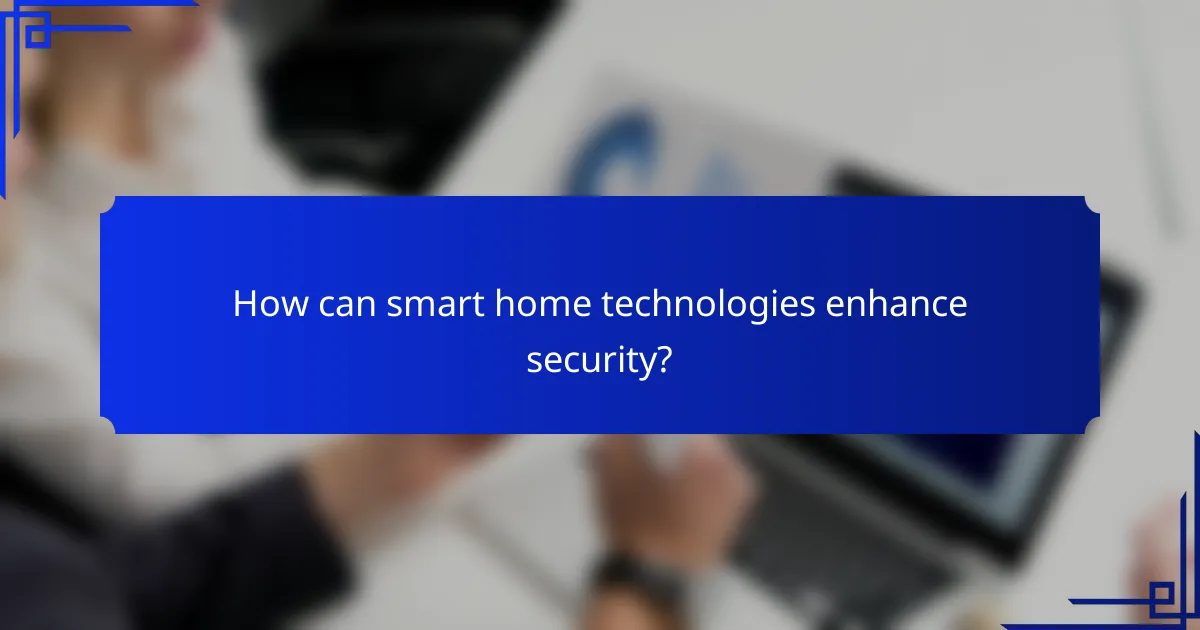
How can smart home technologies enhance security?
Smart home technologies significantly enhance security by integrating devices that monitor, control, and protect your home environment. These systems provide real-time alerts, remote access, and automation features that deter intrusions and improve overall safety.
Smart security cameras
Smart security cameras offer live video feeds and motion detection alerts, allowing homeowners to monitor their property remotely. Many models include features like night vision, two-way audio, and cloud storage for recorded footage, which can be accessed via smartphone apps.
When selecting a smart camera, consider factors such as resolution, field of view, and whether it requires a subscription for cloud services. Popular options often range from $100 to $300, depending on the features and brand.
Smart locks
Smart locks provide keyless entry and can be controlled via smartphone apps, enabling users to lock or unlock doors remotely. These locks often support temporary access codes for guests and can track entry logs, enhancing convenience and security.
When choosing a smart lock, look for compatibility with your existing door hardware and consider features like auto-locking and integration with other smart home systems. Prices typically range from $100 to $250, depending on the technology and security features.
Alarm systems
Smart alarm systems combine sensors, cameras, and alarms to detect unauthorized access and alert homeowners. Many systems allow for customization, enabling users to set specific zones and receive notifications on their devices when triggered.
Consider systems that offer professional monitoring services for added peace of mind, which usually costs between $10 and $50 per month. Ensure the system complies with local regulations and can integrate with other smart home devices for a comprehensive security solution.
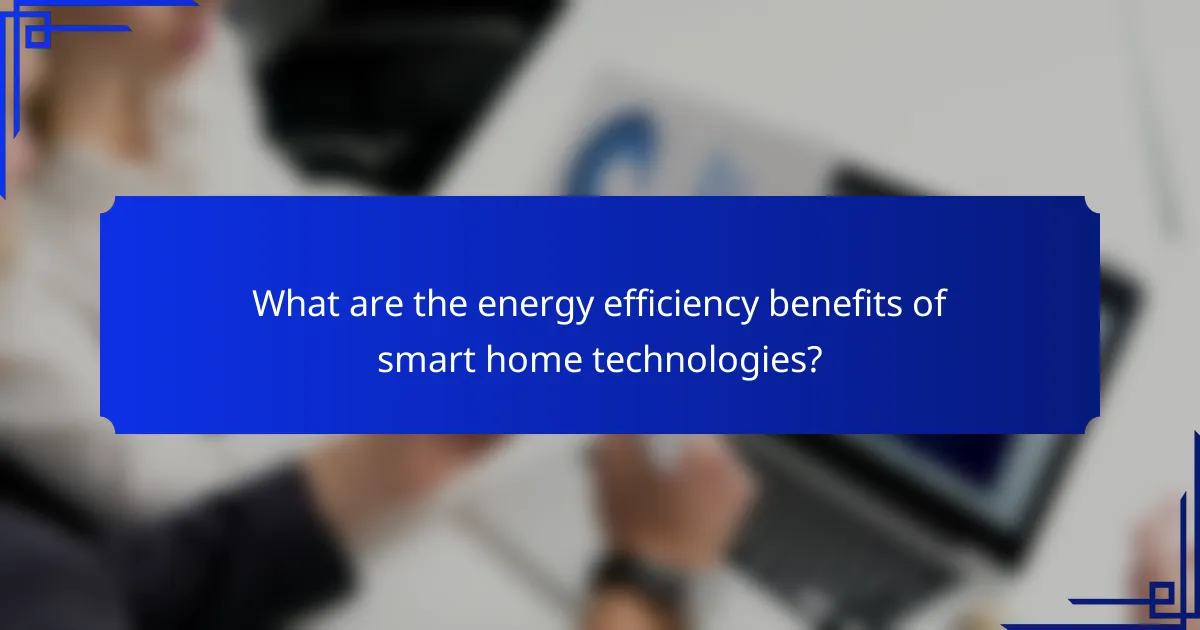
What are the energy efficiency benefits of smart home technologies?
Smart home technologies significantly enhance energy efficiency by optimizing energy consumption and reducing waste. These systems allow homeowners to monitor and control their energy use in real-time, leading to potential savings on utility bills.
Smart thermostats
Smart thermostats learn your schedule and preferences, adjusting heating and cooling automatically to maximize comfort while minimizing energy use. For example, they can lower the temperature when you’re away and raise it before you return, which can lead to savings of around 10-15% on heating and cooling costs.
When selecting a smart thermostat, consider compatibility with your HVAC system and features like remote access and integration with other smart devices. Look for models that offer energy usage reports to help you track savings over time.
Energy monitoring systems
Energy monitoring systems provide insights into your home’s energy consumption patterns, allowing you to identify high-usage appliances and make informed decisions. These systems can help reduce energy waste by highlighting opportunities for efficiency improvements.
Many energy monitors can connect to your smartphone, giving you real-time data and alerts. Consider systems that offer historical data analysis and recommendations for reducing consumption, which can lead to savings of 5-10% on your energy bill.
Smart lighting solutions
Smart lighting solutions enable you to control your lights remotely and set schedules, which can significantly reduce energy usage. Using LED bulbs in conjunction with smart controls can cut lighting costs by up to 80% compared to traditional incandescent bulbs.
When implementing smart lighting, opt for systems that allow for dimming and automation based on occupancy. This not only enhances convenience but also ensures lights are only on when needed, further contributing to energy savings.
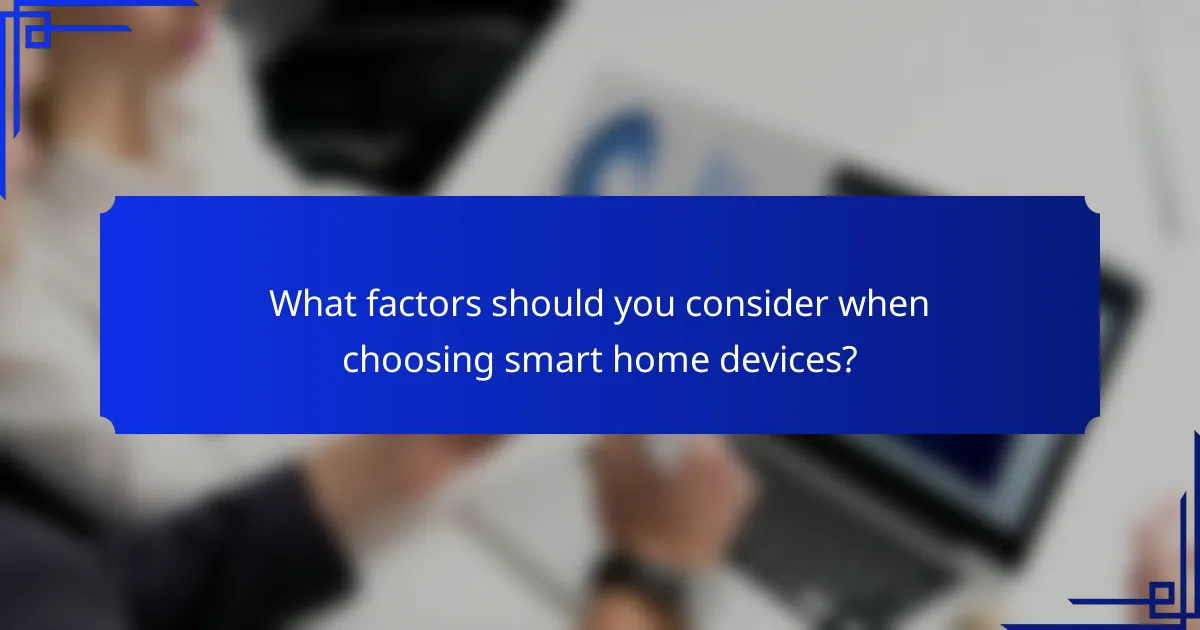
What factors should you consider when choosing smart home devices?
When selecting smart home devices, consider compatibility with your existing systems, ease of use, and your budget. These factors will help ensure that your smart home setup is efficient, user-friendly, and financially feasible.
Compatibility with existing systems
Compatibility is crucial when integrating smart home devices. Ensure that new devices can communicate with your current systems, such as smart hubs, routers, and other appliances. Look for devices that support common standards like Zigbee, Z-Wave, or Wi-Fi to facilitate seamless integration.
Before purchasing, check the manufacturer’s specifications and user reviews to confirm compatibility. For example, if you already use a specific smart speaker, verify that new devices can be controlled through it.
Ease of use
Ease of use is a vital consideration for smart home devices. Look for products with intuitive interfaces, straightforward installation processes, and reliable customer support. Devices that can be easily controlled through mobile apps or voice commands tend to enhance user experience.
Consider testing devices in-store or reading user feedback to gauge their usability. A device that requires extensive setup or complicated programming may lead to frustration and decreased satisfaction.
Cost and budget
Cost is a significant factor when choosing smart home devices. Establish a budget that considers both the initial purchase price and ongoing costs, such as subscriptions or maintenance. Smart devices can range from affordable options to high-end systems, so it’s essential to find a balance that meets your needs without overspending.
Keep an eye out for sales or bundles that can provide better value. Additionally, consider the long-term savings on energy bills that energy-efficient devices may offer, which can offset initial costs over time.
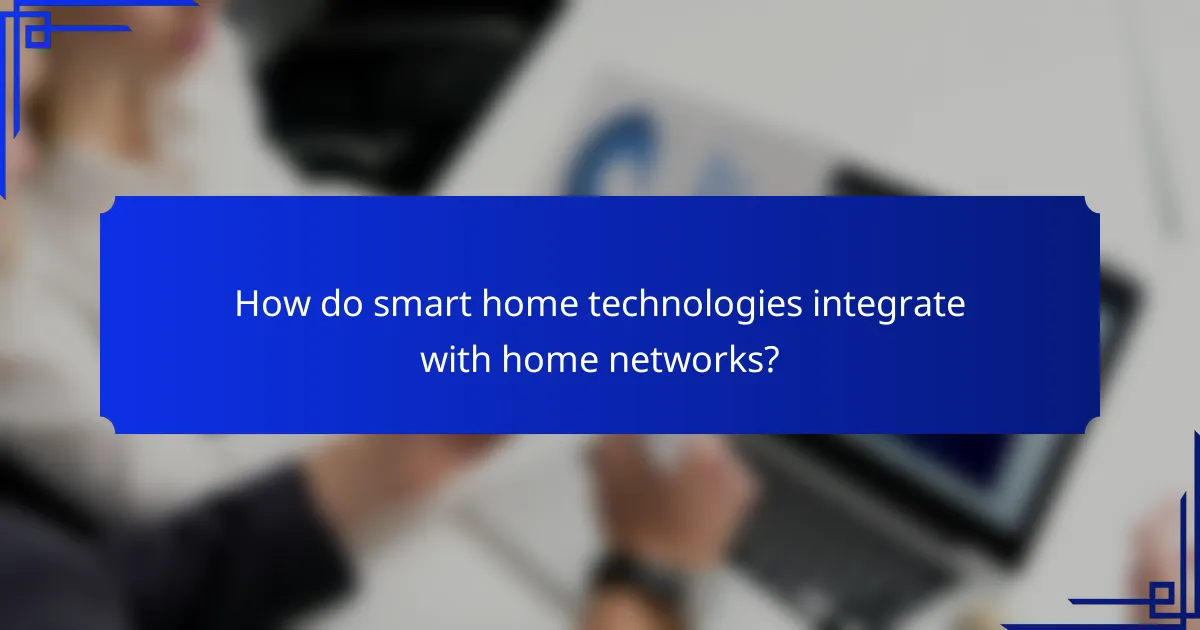
How do smart home technologies integrate with home networks?
Smart home technologies connect to home networks primarily through various wireless communication methods, enabling devices to communicate seamlessly. This integration allows for centralized control, automation, and enhanced security across different smart devices.
Wi-Fi connectivity
Wi-Fi is one of the most common methods for smart home devices to connect to home networks. It provides high-speed internet access, allowing devices like smart cameras and thermostats to transmit data efficiently. However, it can be susceptible to interference and requires a strong signal throughout the home.
When setting up Wi-Fi-connected devices, ensure your router is capable of handling multiple connections and consider using a mesh network for larger homes. This can help maintain a stable connection and improve performance across all devices.
Bluetooth integration
Bluetooth is often used for short-range connections between smart home devices, such as smart locks and speakers. It consumes less power compared to Wi-Fi, making it ideal for battery-operated devices. However, its range is limited, typically around 30 feet, which can be a drawback for larger homes.
For effective Bluetooth integration, ensure devices are within range of each other and consider using Bluetooth hubs to extend connectivity. This can help manage multiple devices without relying solely on Wi-Fi.
Zigbee and Z-Wave protocols
Zigbee and Z-Wave are specialized wireless communication protocols designed for smart home devices, focusing on low power consumption and reliable connectivity. Both protocols create mesh networks, allowing devices to communicate with each other and extend range by relaying signals through multiple devices.
Zigbee operates on the 2.4 GHz frequency, while Z-Wave uses sub-1 GHz frequencies, which can reduce interference from Wi-Fi networks. When choosing between them, consider the specific devices you plan to use, as compatibility may vary. Zigbee tends to support a wider range of devices, while Z-Wave is known for its robust security features.
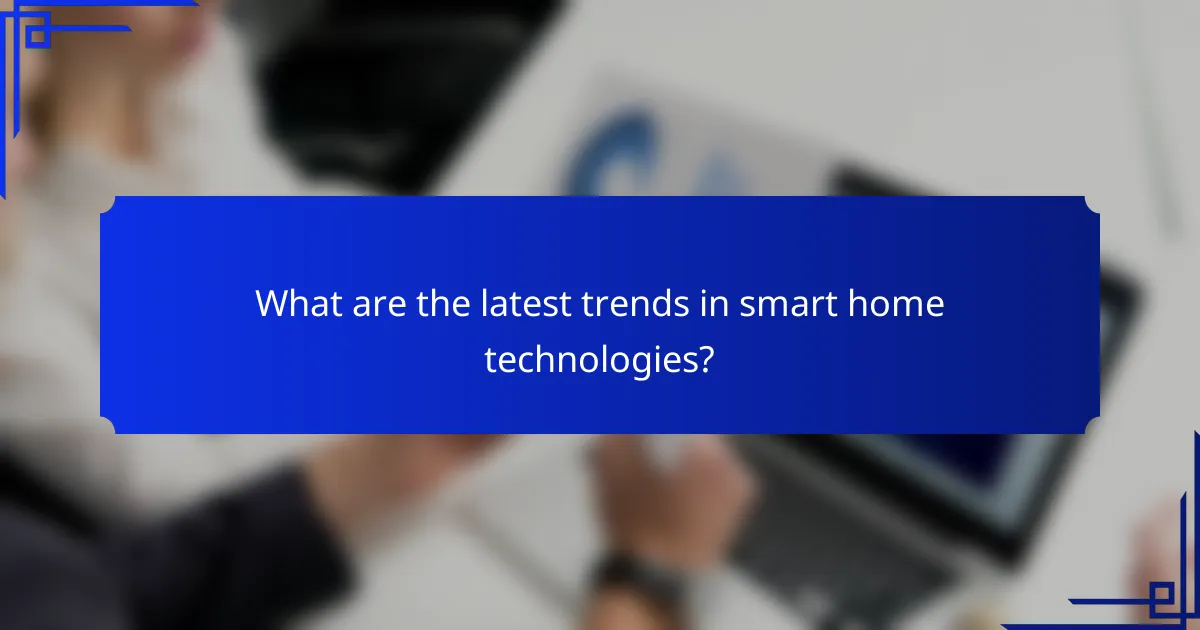
What are the latest trends in smart home technologies?
The latest trends in smart home technologies focus on enhancing automation, improving security, and increasing energy efficiency. These advancements are driven by innovations in artificial intelligence, user demand for privacy, and the need for sustainable living solutions.
AI-driven automation
AI-driven automation is transforming smart homes by enabling devices to learn user preferences and behaviors. This allows systems to anticipate needs, such as adjusting lighting or temperature based on time of day or occupancy patterns.
For example, smart thermostats can optimize heating and cooling schedules, potentially reducing energy costs by 10-20%. Homeowners should consider integrating AI systems that can connect various devices for seamless operation, enhancing convenience and efficiency.
Increased focus on privacy
As smart home technologies proliferate, there is a growing emphasis on user privacy and data security. Consumers are increasingly concerned about how their personal information is collected and used by smart devices.
To address these concerns, manufacturers are implementing stronger encryption methods and providing clearer privacy policies. Homeowners should prioritize devices that offer robust security features, such as two-factor authentication and regular software updates, to protect their data from potential breaches.
